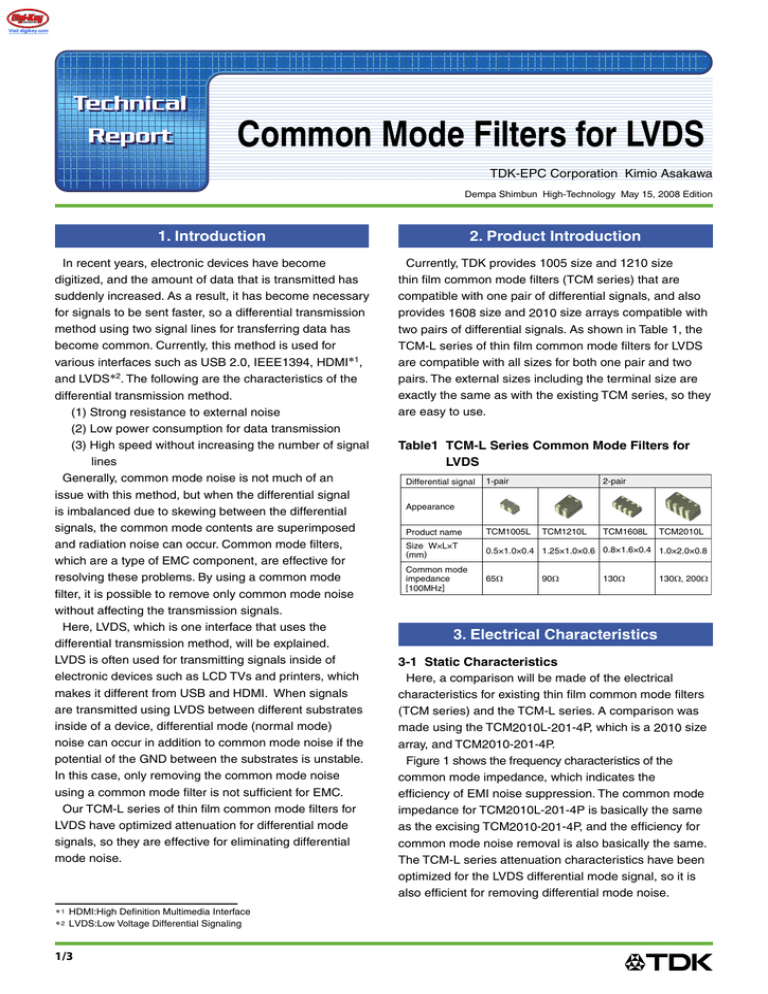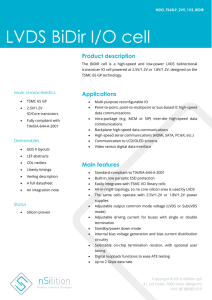Common Mode Filters for LVDS - Digi-Key
advertisement

Common Mode Filters for LVDS TDK-EPC Corporation Kimio Asakawa Dempa Shimbun High-Technology May 15, 2008 Edition 1. Introduction 2. Product Introduction In recent years, electronic devices have become digitized, and the amount of data that is transmitted has suddenly increased. As a result, it has become necessary for signals to be sent faster, so a differential transmission method using two signal lines for transferring data has become common. Currently, this method is used for various interfaces such as USB 2.0, IEEE1394, HDMI∗1, and LVDS∗2. The following are the characteristics of the differential transmission method. (1) Strong resistance to external noise (2) Low power consumption for data transmission (3) High speed without increasing the number of signal lines Generally, common mode noise is not much of an issue with this method, but when the differential signal is imbalanced due to skewing between the differential signals, the common mode contents are superimposed and radiation noise can occur. Common mode filters, which are a type of EMC component, are effective for resolving these problems. By using a common mode filter, it is possible to remove only common mode noise without affecting the transmission signals. Here, LVDS, which is one interface that uses the differential transmission method, will be explained. LVDS is often used for transmitting signals inside of electronic devices such as LCD TVs and printers, which makes it different from USB and HDMI. When signals are transmitted using LVDS between different substrates inside of a device, differential mode (normal mode) noise can occur in addition to common mode noise if the potential of the GND between the substrates is unstable. In this case, only removing the common mode noise using a common mode filter is not sufficient for EMC. Our TCM-L series of thin film common mode filters for LVDS have optimized attenuation for differential mode signals, so they are effective for eliminating differential mode noise. Currently, TDK provides 1005 size and 1210 size thin film common mode filters (TCM series) that are compatible with one pair of differential signals, and also provides 1608 size and 2010 size arrays compatible with two pairs of differential signals. As shown in Table 1, the TCM-L series of thin film common mode filters for LVDS are compatible with all sizes for both one pair and two pairs. The external sizes including the terminal size are exactly the same as with the existing TCM series, so they are easy to use. *1 *2 HDMI:High Definition Multimedia Interface LVDS:Low Voltage Differential Signaling 1/3 Table1 TCM-L Series Common Mode Filters for LVDS Differential signal 1-pair 2-pair Appearance Product name TCM1005L Size W×L×T (mm) TCM1210L 0.5×1.0×0.4 1.25×1.0×0.6 0.8×1.6×0.4 1.0×2.0×0.8 Common mode impedance [100MHz] 65Ω 90Ω TCM1608L 130Ω TCM2010L 130Ω, 200Ω 3. Electrical Characteristics 3-1 Static Characteristics Here, a comparison will be made of the electrical characteristics for existing thin film common mode filters (TCM series) and the TCM-L series. A comparison was made using the TCM2010L-201-4P, which is a 2010 size array, and TCM2010-201-4P. Figure 1 shows the frequency characteristics of the common mode impedance, which indicates the efficiency of EMI noise suppression. The common mode impedance for TCM2010L-201-4P is basically the same as the excising TCM2010-201-4P, and the efficiency for common mode noise removal is also basically the same. The TCM-L series attenuation characteristics have been optimized for the LVDS differential mode signal, so it is also efficient for removing differential mode noise. Figure 1 Common mode impedance frequency characteristics Common mode impedanc(Ω) 10000 1000 TCM2010L-201-4P 100 TCM2010-201-4P 10 1 1 10 100 Frequency(MHz) 1000 10000 3-2 LVDS Signal Waveform This section will give a comparison of the signal waveforms when the TCM-L series is used for LVDS signals. Figure 2 shows the evaluation substrate that was used. Signals that were output from a computer DVI port were converted to LVDS and transferred. The LVDS clock frequency was 75MHz, and the data frequency was 525MHz. The LVDS signal waveforms were measured at both the substrates for sending and for receiving. The LVDS signal was measured at the sending side after passing a common mode filter, and was measured for Figure 2 LVDS evaluation substrate Digital storage oscilloscope TCM Receiving side substrate Sending side substrate Data SXGA or XGA DVI Receiver 100Ω LVDS Receiver LVDS Transmitter Clock DVI port Waveform measurement point (Sending side) PC Waveform measurement point (Receiving side) Figure 3-1 LVDS signal waveform (Sending side) Obvious waveform ringing No common mode filter Remaining waveform ringing Using TCM2010-201-4P Waveform ringing cancelled Using TCM2010L-201-4P Figure 3-2 LVDS signal waveform (Receiving side) No common mode filter 2/3 Using TCM2010-201-4P Using TCM2010L-201-4P Figure 4 Radiation noise measurement results No common mode filter Level[dB(µV/m)] 80 60 40 20 0 50 100 Frequency (MHz) 500 1000 Using TCM2010-201-4P Noise not suppressed at 800MHz 80 Level[dB(µV/m)] the receiving side before the end terminal resistance. Figure 3-1 shows the transmission waveform (eye pattern) for the sending side. Waveform ringing was obvious when no common mode filter was used, and the waveform ringing was not cancelled when the existing TCM2010-201-4P was used. On the other hand, when the TCM2010L-201-4P was used, waveform ringing was cancelled, and the eye pattern became large. This is because the high frequency differential mode noise included in the ringing was removed. Next, Figure 3-2 shows the transmission waveform for the receiving side. Ringing appeared at the receiving side when no common mode filter was used. On the other hand, when the TCM2010L-201-4P was used, ringing did not occur. Waveforms for the sending side rose gradually, but it was confirmed that there was no problem with the receiving side because the high frequency contents were attenuated when it passed the LVDS cable. 60 40 20 0 50 100 Frequency (MHz) 500 1000 Using TCM2010L-201-4P Overall noise level was reduced suppression using the TCM-L series. The evaluation substrate was the same as when evaluating the waveforms in the previous section. However, in order to confirm radiation noise at high frequencies, the clock frequency for LVDS was increased to 135MHz, and the data frequency was increased to 945MHz. When compared to when no common mode filter was used, it was confirmed that the noise level over the whole frequency range, which was 500MHz and higher, was reduced by using TCM2010L-201-4P. The noise suppression was not sufficient when the existing TCM2010-201-4P (800MHz common mode filter) was used, indicating that the new series is effective for cases when the existing common mode filter is not effective. 80 Level[dB(µV/m)] 3-3 Radiation Noise Suppression Efficiency Figure 4 shows the efficiency for radiation noise 60 40 20 0 50 100 Frequency (MHz) 500 1000 4. Conclusion This document explained techniques related to signal waveforms and removing radiation noise using the TCM-L series of thin film common mode filters for LVDS. Actual measurements using LVDS evaluation substrates showed that the TCM-L series is effective for removing LVDS differential mode noise. Thin film common mode filters for LVDS were introduced this time. It is expected that interfaces using differential transmission will continue to increase along with an increase in the amount of transmitted data. It is also expected that transmission signal speed will increase, so the need for EMC will become even more important. TDK will continue to develop optimized common mode filters for various interfaces using our EMC design theory, evaluation techniques, and conductor pattern forming technology for thin film magnetic heads. • Please note that the articles from the May 15, 2008 Edition of the Dempa Shimbun contained in this chapter have been edited by our company. 3/3



